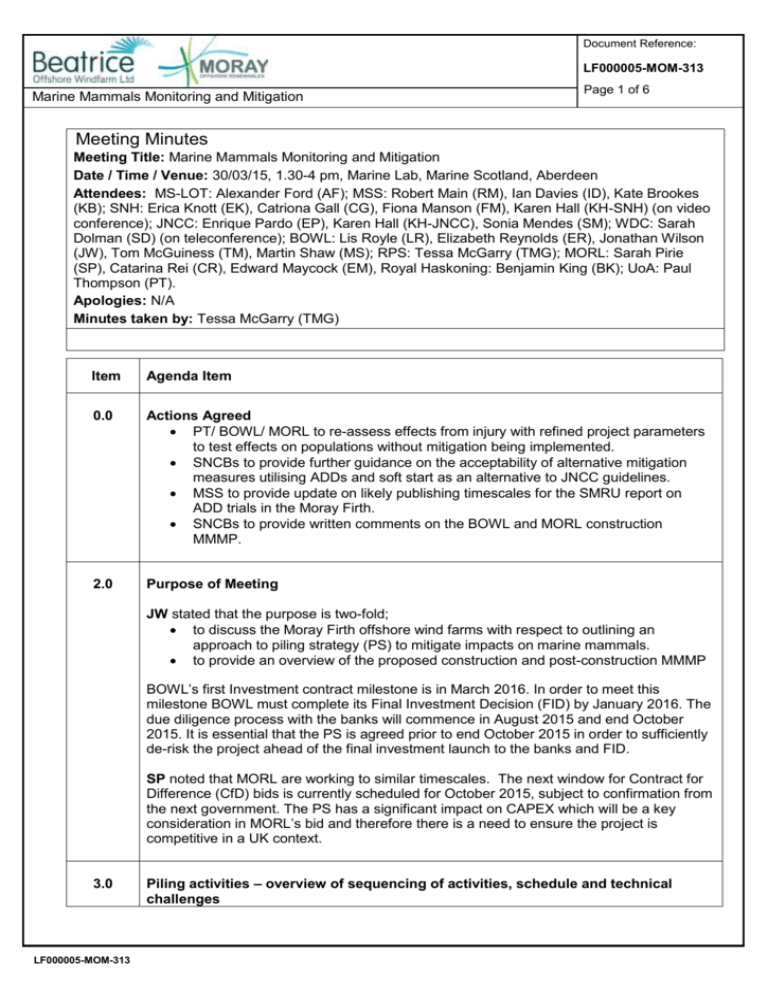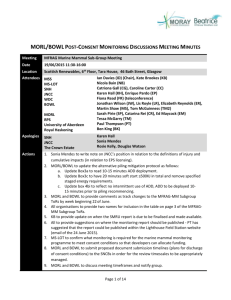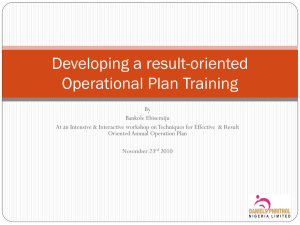Open
advertisement

Document Reference: LF000005-MOM-313 Marine Mammals Monitoring and Mitigation Page 1 of 6 Meeting Minutes Meeting Title: Marine Mammals Monitoring and Mitigation Date / Time / Venue: 30/03/15, 1.30-4 pm, Marine Lab, Marine Scotland, Aberdeen Attendees: MS-LOT: Alexander Ford (AF); MSS: Robert Main (RM), Ian Davies (ID), Kate Brookes (KB); SNH: Erica Knott (EK), Catriona Gall (CG), Fiona Manson (FM), Karen Hall (KH-SNH) (on video conference); JNCC: Enrique Pardo (EP), Karen Hall (KH-JNCC), Sonia Mendes (SM); WDC: Sarah Dolman (SD) (on teleconference); BOWL: Lis Royle (LR), Elizabeth Reynolds (ER), Jonathan Wilson (JW), Tom McGuiness (TM), Martin Shaw (MS); RPS: Tessa McGarry (TMG); MORL: Sarah Pirie (SP), Catarina Rei (CR), Edward Maycock (EM), Royal Haskoning: Benjamin King (BK); UoA: Paul Thompson (PT). Apologies: N/A Minutes taken by: Tessa McGarry (TMG) Item Agenda Item 0.0 Actions Agreed PT/ BOWL/ MORL to re-assess effects from injury with refined project parameters to test effects on populations without mitigation being implemented. SNCBs to provide further guidance on the acceptability of alternative mitigation measures utilising ADDs and soft start as an alternative to JNCC guidelines. MSS to provide update on likely publishing timescales for the SMRU report on ADD trials in the Moray Firth. SNCBs to provide written comments on the BOWL and MORL construction MMMP. 2.0 Purpose of Meeting JW stated that the purpose is two-fold; to discuss the Moray Firth offshore wind farms with respect to outlining an approach to piling strategy (PS) to mitigate impacts on marine mammals. to provide an overview of the proposed construction and post-construction MMMP BOWL’s first Investment contract milestone is in March 2016. In order to meet this milestone BOWL must complete its Final Investment Decision (FID) by January 2016. The due diligence process with the banks will commence in August 2015 and end October 2015. It is essential that the PS is agreed prior to end October 2015 in order to sufficiently de-risk the project ahead of the final investment launch to the banks and FID. SP noted that MORL are working to similar timescales. The next window for Contract for Difference (CfD) bids is currently scheduled for October 2015, subject to confirmation from the next government. The PS has a significant impact on CAPEX which will be a key consideration in MORL’s bid and therefore there is a need to ensure the project is competitive in a UK context. 3.0 LF000005-MOM-313 Piling activities – overview of sequencing of activities, schedule and technical challenges Document Reference: LF000005-MOM-313 Marine Mammals Monitoring and Mitigation Page 2 of 6 JW highlighted that the BOWL project entered the front end engineering design (FEED) stage in Q4 2014 which involves significant engineering work / studies to confirm key project parameters. E.g. the original application considered installation of up to 277 turbines, but now the project design specifies 86. The piling operation for BOWL is likely to occur over 2 years (April – Sept). The ES assessed 3 years of continuous piling. In terms of understanding ground conditions – over 50% of borehole assessments have been completed. The pile driving energy is likely to be between 1200 – 1800 kJ across the majority of the site but BOWL cannot confirm maximum energy until the remaining of the geotechnical investigation is completed. The maximum hammer energy assessed in the ES was 2300 kJ. CR stated that MORL is in a slightly different position. MORL are working towards the next CfD application so detailed project information is not currently available. MORL have undertaken the first phase of their geotech campaign on site. MORL are likely to build the Eastern Development Area (i.e. the three consented wind farms) through a phased approach although it is not possible to say what the phasing will be yet. It is likely that shallower areas developed first due to costs of developing deeper waters. ID queried if ‘phasing’ would mean build one phase and then build another phase. CR replied that MORL cannot give any certainty on this yet until award of CfD. SP noted that MORL will need to develop the most competitive project that is economically favourable with a high energy output. Economic drivers will be the key behind developing the bid. EM highlighted that MORL will consider as a starting point the project considered for the previous CfD application and how it can be improved. JW – BOWL and MORL are aligned on the approach to the piling mitigation strategy even though timing of the projects and the delivery of the Piling Strategies are slightly different. Presentation from BOWL and MORL engineers on the methods and engineering requirements of pile-driving operations: TM/MS – showed a short film demonstrating the key activities associated with pile-driving operations, including vessel set-up, deployment of a pile installation frame, and pile-driving itself. TM/ MS/ EM presented the engineering approach to piling including description of equipment used, understanding installation process, example of pile driving energy profile, example of piling operational sequence and durations, different options for piling and jacket installation campaign, potential for use of relief drilling. (see presentation document attached with these minutes). TM/MS/EM explained that breaks in pile driving can occur due to a number of reasons, whether planned or unplanned, and the engineering consequences can also vary e.g. pauses could lead to longer piling duration and the requirement for higher hammer energy to ‘get the pile moving’ due to soil consolidation. The ideal is to minimise the blow energy whilst maintaining a consistent drive rate, in order to reduce fatigue damage to the pile and reduce wear and failure rate of driving tools. There is a strong incentive to not delay piling from both engineering and ecological perspective. LF000005-MOM-313 Document Reference: LF000005-MOM-313 Marine Mammals Monitoring and Mitigation Page 3 of 6 The programme impact of increased piling durations was explained in the context of developers requiring to identify mitigation measures that do not cause significant delays to construction programmes. Delays in piling activities could delay construction into periods of sub-optimal weather therefore leading to longer durations of downtime. Ultimately this will delay the overall piling campaign and lead to potentially longer piling programmes, or result in the requirement for a second vessel (i.e. increase in spatial extent of noise over same period). KB and EK queried about ‘weather sensitive’ operations during piling activities. EM replied that the main ‘weather sensitive’ operation was whilst lifting the pile prior to pile driving. 4.0 Marine mammal mitigation PT presented an outline on the BOWL and MORL position on piling mitigation measures for marine mammals in the Moray Firth. PT noted that the JNCC guidelines are draft guidelines, and state that an alternative protocol can be suggested as mitigation as long as developers demonstrate that can be effective. The effectiveness of the current guidelines can be questioned in that methods of detection of marine mammals by MMOs are not effective and that currently there is reluctance to investigate more efficient alternative options due to confidence in the guidelines. Instead mitigation should consider local conditions (i.e. the Moray Firth for the MORL and BOWL projects). The key species are bottlenose dolphin and harbour seals but there are also high densities of harbour porpoise and this has implications for engineering schedule. As concluded in the BOWL and MORL ESs the key focus for mitigation is to minimise risk of death or injury. For the marine mammal species that the projects are required to mitigate for, this zone is <40 m. Evidence from other studies e.g. Moray Firth (MF) ports and harbours work show limited evidence for displacement of Bottlenose Dolphins (BND). There is, however, an appreciation that the mitigation design needs to be ‘fit-for-purpose’. PT further outlined proposed site-specific mitigation using Acoustic Deterrent Devices (ADDs) and soft start (minimum energy at the start of piling driving) with a mitigation zone determined by injury criteria. PT provided an overview of ADD technology; with Lofitech highlighted as a tried and tested device that could be useful for both HP and harbour seal, as published data provides evidence of this. PT outlined the implications of fully complying with JNCC guidelines in the Moray Firth; including the risk of delays that could lead to longer piling campaigns, requirement for a higher hammer energy due to pile consolidation after breaks, and increased likelihood of simultaneous piling (spatial extent of noise disturbance). Discussion progressed on the presentation provided. KH-JNCC noted that there are limitations to MMOs and PAM but that they are practical way to reduce risk to marine mammals and suggested that there may be areas for improvement. There are issues with testing the effectiveness of the current mitigation guidelines however JNCC are trying to investigate this. The guidelines are a starting point. The key concern is that ADDs have not been used on its own without PAM and MMOs as mitigation before. The ORJIP programme is also considering the effectiveness of ADDs. LF000005-MOM-313 Document Reference: LF000005-MOM-313 Marine Mammals Monitoring and Mitigation Page 4 of 6 PT noted that TTS and PTS were assessed conservatively in the ESs (and regarded as acceptable effects) and that if the intention is to mitigate PTS then the mitigation zone would be several kms which could not be mitigated with MMOs and PAM (using the current JNCC guidelines). EK highlighted that the JNCC guidelines allow for development of a new approach to mitigation. Who is expected to pick up on this? There is also a need to consider the current draft HP SACs proposals. The conservation objectives will be different in case of a designation in the Moray Firth so there would need to be a clear understanding of the effects of piling on the HP population. ID highlighted that there are currently no details available on the proposed HP draft SACs and therefore no coherent view on population effects. There is a map of dSACs being considered but it has not been published yet. MSS are open to discussions on the draft SAC proposals. PT noted that MORL/BOWL/UoA haven’t seen the map of proposed HP dSACs so advice on the current draft proposals is required quickly. The new version of MMMP has been changed to test effectiveness of ADDs so should answer some of the concerns. SP stated that MORL would value some guidance as soon as possible as the ORJIP timeline is currently uncertain and developers require to de-risk the projects this year through the submission of project’s Piling Strategies. KH –JNCC mentioned that JNCC are keen to consider alternative mitigation measures but that the proposed mitigation is very different to what is in the guidelines which is a key risk. The developers will need to look at reducing this risk. The timelines presented for BOWL and MORL suggest that projects will be piling for a number of years so even if alternative mitigation is not instigated in the first year, there is still time to test mitigation measures to use later. Is there potential for Dogger Bank to test this? Can results of ORJIP be applied to Moray Firth? PT- highlighted that the results from ORJIP will not be useful for BOWL’s timelines, but could be of use to MORL (depending on MORL’s construction programme and ORJIP delivery timescales). PT added that one device (Lofitech) had been tested in the Moray Firth recently by SMRU (MS commissioned report) and asked MSS for an update on publishing timescales. KB mentioned that the SMRU report is still under review. SD noted that species diversity is different in different parts of the UK so what works in one area may not work in another area. A report by P. Lepper shows that ADDs themselves could cause injury. EK stated that these questions will need to be raised with ORJIP. There will need to be more consideration and justification about worst case in the ESs and most likely scenario. By reducing all impacts it is not clear as to population consequences. PT noted that it is a concern if developers are expected to test the effectiveness of ADDs. Due to the more refined project descriptions (fewer turbines, shorter pile-driving programmes etc.) the population consequences of pile-driving will be lower than that assessed in the ESs. The key question is whether developers can use ADDs as LF000005-MOM-313 Document Reference: LF000005-MOM-313 Marine Mammals Monitoring and Mitigation Page 5 of 6 mitigation. Given the key receptors are seals, the limitations of MMO/PAM, could seriously constrain opportunities to pile at night. LR/SP highlighted that developers need to able to pile at all times when the weather permits (i.e. day and night). ID enquired what the circumstances are in which developers can pile at night. KH-JNCC highlighted that other wind farm developments have been allowed to pile at night. The tool currently available to use is PAM, however in the Moray Firth developers are required to consider harbour seals and therefore there is a need for a combination of PAM and ADD. EK noted that if SNCBs approved mitigation that is not effective there could be population consequences. Developers are required to think about the issues raised. ID stated that the SNCBs should come up with goal posts/targets. PT confirmed that the BOWL and MORL developments are at a stage where it will be challenging, if not impossible to fully confirm that ADDs are more effective than the current JNCC guidelines. Therefore, the only alternative approach may be for BOWL and MORL to re-assess impacts based on refined design envelopes to ascertain if there is any significant risk to populations if ADD mitigation does not work. ACTIONS: 5.0 PT/ BOWL/ MORL to re-assess effects from injury with refined project parameters to test effects on populations without mitigation being implemented. SNCBs to provide further guidance on the acceptability of alternative mitigation measures utilising ADDs and soft start as an alternative to JNCC guidelines. MSS to provide update on likely publishing timescales for the SMRU report on ADD trials in the Moray Firth. Approach to development of Piling Strategy document JW outlined contents of what would be included within the BOWL PS document, including the predicted hammer energies to be used across the site based on soil conditions at each WTG location. The PS will present information in line with the consent condition (method, duration, soft start procedure, max energy). PS will also re-visit the assessment of effects based on reduced pile diameter (PD) and updated piling details. Finally will present mitigation and associated monitoring in line with the PS (with cross references to the EMP and PEMP). CR noted that MORL is undertaking a pile drivability study and will present anticipated maximum hammer energies and piling durations in zones across their sites based on the different ground conditions. 6.0 MORL and BOWL construction and post-construction MMMP PT outlined the proposed construction MMMP for BOWL and MORL. High priority species are still harbour seal and bottlenose dolphin with, harbour porpoise as a medium priority LF000005-MOM-313 Document Reference: LF000005-MOM-313 Marine Mammals Monitoring and Mitigation Page 6 of 6 species. Certain studies in the pre-construction MMMP will be repeated during construction. In addition to this, WP3 will focus on the monitoring of responses of harbour seal and harbour porpoises to alternative mitigation (ADD and soft starts). KB agreed that the programme covers the Moray Firth suitably and highlighted that the key species for the East coast is BND. PT highlighted that the programme can support the integration of east coast data (collected in Forth and Tay) with the MF data. ACTIONS: SNCBs to provide written comments on the BOWL and MORL construction MMMP. 7.0 Update on results of pre-construction MMMP and ongoing strategic work PT provided an update on pre-construction monitoring since December 2014. 13 seals were successfully tagged in February. Further C-POD data has been collected and winter seal counts have been completed. There is limited use of tagged seals of the BOWL and MORL sites. One individual has been tracked to Orkney. 9.0 Next Steps and AOB ID re-iterated the key actions: PT/ BOWL/ MORL to re-assess effects from injury with refined project parameters to test effects on populations without mitigation being implemented. SNCBs to provide further guidance on the acceptability of alternative mitigation measures utilising ADDs and soft start as an alternative to JNCC guidelines. MSS to provide update on likely publishing timescales for the SMRU report on ADD trials in the Moray Firth. SNCBs to provide written comments on the BOWL and MORL construction MMMP. LF000005-MOM-313









